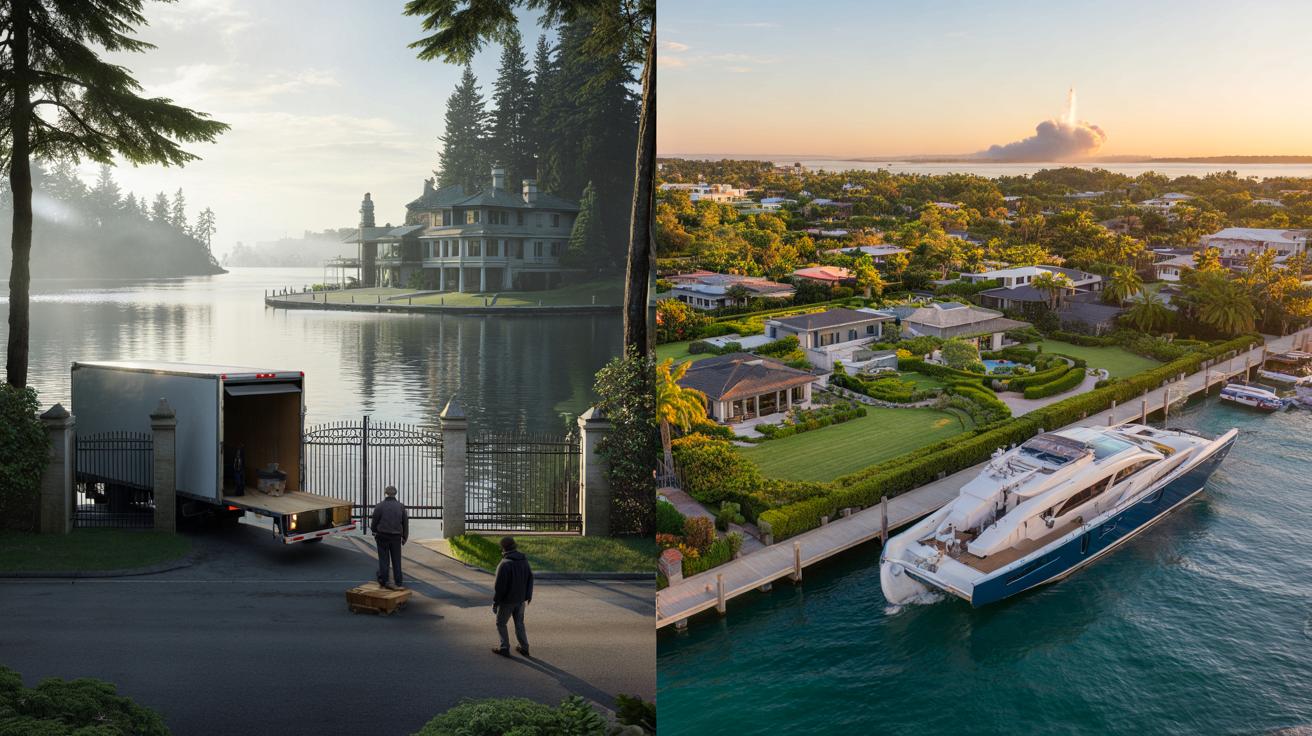It’s a property story that reads like a map of money in motion — from misty Lake Washington mornings to the warm hush of Indian Creek at dusk.
It was the kind of grey Seattle morning that blurs lake and sky into one cool sheet. A pair of moving trucks idled by the wrought-iron gates, breathy engines clouding the air as a small crowd of neighbours slowed their jogs, glancing, then glancing again. The water was flat as a sheet of glass, and the city seemed to hold its breath. By the boathouse, a staging team in black puffer jackets shepherded crates marked “fragile”, then swung the gate shut. Word spread fast — a $63 million deal, a new local record, and an era quietly packed into padded boxes. In the cul-de-sac, someone murmured: “Miami.” What comes next is the tell.
A record on the lake — and the message behind it
Sixty-three million dollars isn’t just a price tag; it’s a flare. The sale of Bezos’s Seattle-area estate, a landmark on Lake Washington’s gold-plated shoreline, resets the ceiling for the region’s priciest homes and hints at a shifting centre of gravity for tech wealth. Brokers talk about “comp” trails and buyer psychology, yet what people feel is simpler: a door has closed, and the room sounds different. **For a city that grew up on Amazon’s heartbeat, a record sale carries the hush of finality and the buzz of possibility at the same time.** It feels like the skyline just tilted a fraction toward the sun.
Look at the house itself and the number starts to make sense. A long sweep of lawn, a private dock, sheltering cedars that make even the wind lower its voice. Bezos bought near here in the late ’90s, back when “one-click” was an idea, not a lifestyle. The estate evolved — expansions, careful landscaping, interiors that whisper money rather than shout it. Sales like this tend to be choreographed off-market or released in carefully rationed bites, the way a symphony edges toward its final note. We’ve all had that moment when a place you knew changes owners and suddenly feels more like a story than a home.
The logic is as clear as the ledger. Washington has flirted with wealth taxes and already levies a capital gains tax; Florida does not. Blue Origin’s activity orbits Florida’s Space Coast, and Miami is where Bezos’s parents live. Add sunshine, calmer waters for mega-yachts, and Indian Creek’s gated discretion, and you get a simple calculation: proximity, privacy, and a friendly tax climate. **When the personal, the professional, and the fiscal line up, people move — even when they already have everything.** It isn’t a rejection of Seattle so much as a realignment with a new cadence of work, family, and legacy.
Inside the Miami play: the discreet art of buying privacy
There’s a method to that $237 million Miami compound. Ultra-high-net-worth buyers often assemble their sanctuary piece by piece, acquiring adjacent lots to widen their buffer from the world. On Indian Creek, the strategy is a masterclass: separate parcels united by hedges and marina-grade docks, security embedded into the very geography, and sightlines engineered to hold back cameras. Think layered ownership via LLCs, clean title history, seawall due diligence, and elevation checks that anticipate both rising tides and insurance premiums. The result isn’t ostentation. It’s silence, purchased in acres and angles.
Can ordinary homeowners learn from this? Some parts, yes. Stage your place not for fantasy but for flow: sightlines, light, and a couple of high-impact fixes that photograph well. Time your listing for moments when your market is hungry rather than crowded. Negotiate in straight lines; buyers trust clarity. Let’s be honest: nobody really does that every day. Yet scaling the playbook matters — the Miami tactic is just an exaggerated version of basics that work from Hackney to Hove: privacy where it counts, maintenance that outscores mood, and a narrative that makes the house feel inevitable to the right buyer.
There’s also the tempo of discretion. Deals at this level move in quiet loops — family offices, lawyers, a shortlist of brokers who answer on the first ring and never text the wrong emoji. You don’t need billions to borrow the rhythm: fewer voices, tighter details, and a plan for the “what if” calls at 11 p.m.
“Real privacy isn’t hiding; it’s designing a life that leaves less surface for the world to grab.”
- Map your must-haves before money talks: title, surveys, flood data, and insurance quotes.
- Control the perimeter: hedging, frosted glazing, and smart access systems beat bigger fences.
- Stage for daylight hours and phone screens; morning photos sell serenity.
- Use clean entities for ownership to simplify future exits and taxes.
- Build an exit plan the day you buy — liquidity follows preparation.
The new map of money isn’t where you think
The Pacific Northwest gave us the internet’s cartographers; Miami is fast becoming their waterfront annex. Bezos’s move is part lifestyle, part logistics, part statement that the American atlas of influence is being redrawn along sun-belts and spaceports. That doesn’t erase Seattle’s story. Amazon still hums, engineers still argue about latency over coffee, and the rain keeps its own rhythm. Yet the symbolism sticks: a record sale on Lake Washington, a mega-compound on Indian Creek, and a sense that the next big decade for certain fortunes wants warmer weather and shorter flights to rockets.
For readers, what matters is less the headline number than the pattern. Where money sleeps, it builds power in concentric circles — contractors, charities, restaurants, schools. Prices follow confidence. So do ideas. **If the richest man in the neighbourhood changes neighbourhoods, everyone else recalibrates.** Some will eye new listings. Some will hold tighter. Others will simply walk their dogs past a newly quiet gate and wonder how silence can be worth so much.
| Point clé | Détail | Intérêt pour le lecteur |
|---|---|---|
| Record $63m Seattle sale | Sets a new benchmark for Lake Washington luxury property | Signals pricing power and future comps in premium markets |
| $237m Miami compound | Assembled parcels on Indian Creek for privacy and security | Shows how “buy-next-door” builds value and calm |
| Tax and lifestyle shift | Florida’s tax regime and proximity to Blue Origin operations | Explains why high-net-worth migrations reshape cities |
FAQ :
- Was the $63m sale really a local record?Yes. The deal set a new high-water mark for the Seattle-area luxury market, redefining the top end of Lake Washington pricing.
- Where exactly is the Seattle mansion?On the Lake Washington shoreline in the ultra-prime Eastside belt, among estates known for long lawns, private docks, and deep privacy.
- Why Miami — and why Indian Creek?Privacy, security, family ties, proximity to Blue Origin’s Florida footprint, and a tax environment that suits long-term planning.
- What does this mean for Seattle property values?Expect ripple effects at the very top end: higher comps, bolder pricing on rare waterfronts, and sharper staging for trophy listings.
- How big is the Miami compound, really?The figure reflects multiple purchases totalling $237m on Indian Creek, creating a unified, heavily buffered waterfront estate.









So this is what “realignment” looks like—cashing out in Seattle and surfing Florida’s tax breeze. It’s legal, sure, but it defintely widens the gap. When the richest move for policy perks, the rest pick up the tab, dont they? Enjoy the sunshine, I guess.